The Effects of Pilot Structure on the Lean Ignition Characteristics of the Internally Staged Combustor
Abstract
1. Introduction
2. Research Methods
2.1. Numerical Calculation Methods
2.1.1. Geometric Model
2.1.2. Model and Boundary Conditions
2.1.3. Grid Division and Independence Verification
2.2. Experimental System
3. Verification of Numerical Calculation Method Accuracy
4. Results and Discussion
4.1. Ignition Process Analysis
4.2. Influence of the Diameter of the Auxiliary Fuel Nozzles on Ignition Performance
4.3. Influence of Pilot Swirler with Different Rotating Direction Combination on Combustor Ignition Performance
4.4. Influence of the Swirl Number of the Pilot Module Primary Swirlers on Combustor Ignition Performance
4.5. Optimization Scheme for Ignition Performance of the Internally Staged Combustor
5. Conclusions
- (1)
- Changing the diameter of the auxiliary fuel nozzles affects the average droplet size distribution of fuel, thereby affecting the lean ignition limit of the combustor under a constant inlet air flow rate.
- (2)
- Both too-large and too-small swirl numbers of the pilot module primary swirlers are not conducive to broadening the lean ignition limit. Compared to the combination of the same rotating direction for both pilot swirlers, the opposite rotating direction combination shows better lean ignition performance.
- (3)
- Under typical working conditions (inlet air flow rate of 46.7 g/s and ignition energy of 4 J), the lean ignition fuel–air ratio limit is reduced to 0.0121 with the opposite rotating direction combination of pilot swirlers, the diameter of the nozzle diameter is 0.2 mm, and the swirl number of the pilot module primary swirlers is 1.4, showing the best lean ignition performance with a reduction of 32.78% compared to the baseline scheme C1.
Author Contributions
Funding
Data Availability Statement
Conflicts of Interest
References
- Huang, Y. Combustion and Combustion Chamber; Beihang University Press: Beijing, China, 2009; ISBN 9787811248951. [Google Scholar]
- Lin, Y.Z.; Xu, Q.H.; Liu, G.E. Gas Turbine Combustor; National Defence Industry Press: Beijing, China, 2008. [Google Scholar]
- International Standards and Recommended Practices Environmental Protection Annex 16 to the Convention on International Civil Aviation on Volume Aviation Engine Emissions; ICAO: Montréal, QC, USA, 1993.
- Lin, Y.Z.; Peng, Y.H.; Liu, G.E. A Preliminary Study of NOx Emission of staging/Premixed and Prevaporized Lean Combustion Low Emission Combustor Scheme. J. Aerosp. Power 2003, 18, 492–497. [Google Scholar]
- Fu, Z.B.; Lin, Y.Z.; Zhang, C.; Xu, Q.H. Experimental Investigation on Fuel-Staging Mode of Internally-Staged Combustor under Approach Condition. J. Propuls. Technol. 2014, 35, 77–86. (In Chinese) [Google Scholar]
- Liu, D.C.; Dong, Y.X.; Shang, S.T.; Cheng, M.; Shang, M.Z. Numerical simulation of the flow field in a single annular concentric staged combustor. J. Aerosp. Power 2010, 25, 1251–1257. (In Chinese) [Google Scholar]
- Mongia, H. Perspective of Combustion Modeling for Gas Turbine Combustors. In Proceedings of the 42nd AIAA Aerospace Sciences Meeting and Exhibit, Reno, NV, USA, 5–8 January 2004; American Institute of Aeronautics and Astronautics: Reston, VA, USA, 2004. [Google Scholar]
- Stouffer, S.; Ballal, D.; Zelina, J.; Shouse, D.; Hancock, R.; Mongia, H. Development and Combustion Performance of High Pressure WSR and TAPS Combustor. In Proceedings of the 43rd AIAA Aerospace Sciences Meeting and Exhibit, Reno, NV, USA, 10–13 January 2005; American Institute of Aeronautics and Astronautics: Reston, VA, USA, 2005. [Google Scholar]
- Fu, Z.B.; Lin, Y.Z.; Zhang, C.; Xu, Q.H. Experiment of combustion performance of internally-staged combustor pilot stage. J. Aerosp. Power 2015, 30, 46–52. (In Chinese) [Google Scholar]
- William, P.; Tyliszczak, A. Large Eddy Simulation of Spark Ignition in a Gas Turbine Combustor. Flow Turbul. Combust. 2010, 85, 711–734. [Google Scholar]
- Wang, X.W.; Huang, Y.; Liu, Y.F.; Sun, L. Effect of the ignition location on lean light-off limits for a gas turbine combustor. Combust. Flame 2022, 245, 17–35. (In Chinese) [Google Scholar] [CrossRef]
- Hervo, L.; Senoner, J.M.; Biancherin, A.; Cuenot, B. Large-Eddy Simulation of Kerosene Spray Ignition in a simplified Aeronautic Combustor. Flow Turbul. Combust. 2018, 101, 603–625. [Google Scholar] [CrossRef]
- Wang, K.X.; Liu, F.Q.; Fan, X.J.; Liu, C.X.; Yang, J.H.; Mu, Y.; Xu, G. Effects of Ignition Position on Ignition Process of Internally-Staged Combustor. J. Propuls. Technol. 2022, 43, 233–242. (In Chinese) [Google Scholar]
- ASME GT2011-45786; Experimental Investigation on Ignition Performance of LESS Combustor. ASME: Vancouver, BC, Canada, 2012.
- ASME GT 2014-25644; Numerical Investigation of Ignition Performance of a Lean Burn Combustor at Sub-Atmospheric Conditions. ASME: Düsseldorf, Germany, 2014.
- Read, R.W. Experimental Investigations into High-Altitude Relight of a Gas Turbine; University of Cambridge: Cambridge, UK, 2008. [Google Scholar]
- ASME GT2010-22625; Experimental Analysis of Altitude Relight under Realistic Conditions Using Laser and High-Speed Video Techniques. ASME: Glasgow, UK, 2010.
- Huang, B.; Qiu, W.; Fang, R.L. Experiment on variable-frequency-energy ignition performance of internally-staged combustor. J. Aerosp. Power 2019, 34, 529–538. (In Chinese) [Google Scholar]
- ASME GT2013-94681; Experimental and Numerical Analysis of an Ignition Sequence in a Multiple-Injectors Burner. ASME: San Antonio, TX, USA, 2013.
- ASME GT-2011-46187; Improvement on Ignition Performance for a Lean Staged Low NOx Combustor. ASME: Vancouver, BC, Canada, 2011.
- Fu, Z.B.; Lin, Y.Z.; Fu, Q.H.; Zhang, C. Effect of different step heights on ignition and blowout performance of internally-staged combustor. J. Aerosp. Power 2014, 5, 1062–1070. (In Chinese) [Google Scholar]
- Wu, H.W.; Chen, H.; Liu, C.X.; Yang, J.H.; Mu, Y.; Cheng, M.; Xu, G. Effect of Pilot-Inner-Staged Swirl on Ignition and Blowout Performance of Combustor. J. Combust. Sci. Technol. 2017, 23, 560–566. (In Chinese) [Google Scholar]
- Liu, Y.; Hui, X.; Wang, J.; Wang, X.; Han, M. Effect of swirl number of pilot stage on ignition performance of centrally-staged combustor. J. Aerosp. Power 2022, 37, 2335–2343. (In Chinese) [Google Scholar]
- Yang, J.H.; Liu, C.X.; Liu, F.Q.; Mu, Y.; Xu, G. Experimental Investigation of Effects of Pilot Swirl Flow Organization on Ignition and LBO Performance for a Staged Combustor. J. Propuls. Technol. 2019, 40, 2050–2059. (In Chinese) [Google Scholar]
- Liu, A.G.; Li, H.Z.; Zhu, T. Effect of Central Staged Combustor Swirl Angle on Combustion Performance. J. Eng. Therm. Energy Power 2019, 34, 16–23. (In Chinese) [Google Scholar]
- Liu, W.; Wang, C.J.; Yu, L.; Zheng, S.; Zeng, W. Experimental investigation on combustion performance of centrally-staged combustor. China Meas. Test 2019, 45, 149–155. [Google Scholar]
- Gui, T.; Fang, R.L.; Qiu, W.; Deng, Y.; Fan, W. Experimental Investigation on Ignition Performance of Coaxial and Divisional High Temperature Rise Combustor. J. Propuls. Technol. 2022, 43, 224–232. (In Chinese) [Google Scholar]
- Xu, L.; Sun, Y.L. Experimental study on ignition and flameout performance of low-pollution combustor. J. Shenyang Aerosp. Ace Univ. 2018, 35, 6. [Google Scholar]
- Li, Y.; Zheng, H.T.; Mu, Y.; Cheng, B. Application of Turbulent Models on Simulation of intense Swirling flow Combustor. In Proceedings of the Asia-Pacific Power and Energy Engineering Conference, Wuhan, China, 25–28 March 2011. [Google Scholar]
- Mongia, H. Recent Progress in Comprehensive Modeling of Gas Turbine Combustion. In Proceedings of the 46th AIAA Aerospace Sciences Meeting and Exhibit, Reno, NV, USA, 7–10 January 2008; American Institute of Aeronautics and Astronautics: Reston, VA, USA, 2008. [Google Scholar]
- Li, L.; Suo, J.Q.; Zheng, L.X. Effect of Rotating Direction on Flow and Temperature Field of Concentric Staged Combustor. J. Northwestern Polytech. Univ. 2020, 38, 1198–1209. [Google Scholar] [CrossRef]
- Guo, X.; Yang, M.; Li, F.; Zhu, Z.; Cui, B. Investigation on Cryogenic Cavitation Characteristics of an Inducer Considering Thermodynamic Effects. Energies 2024, 17, 3627. [Google Scholar] [CrossRef]
- Wu, J.; Xu, P.; Li, L.; Li, Z.; Qi, H.; Wang, C.; Zhang, Y.; Xie, Y.; Tan, D. Multiphase dynamic interfaces and abrasive transport dynamics for abrasive flow machining in shear thickening transition states. Powder Technol. 2024, 446, 120150. [Google Scholar] [CrossRef]
- Li, L.; Lu, B.; Xu, W.; Wang, C.; Wu, J.; Tan, D. Dynamic behaviors of multiphase vortex-induced vibration for hydropower energy conversion. Energy 2024, 308, 132897. [Google Scholar] [CrossRef]

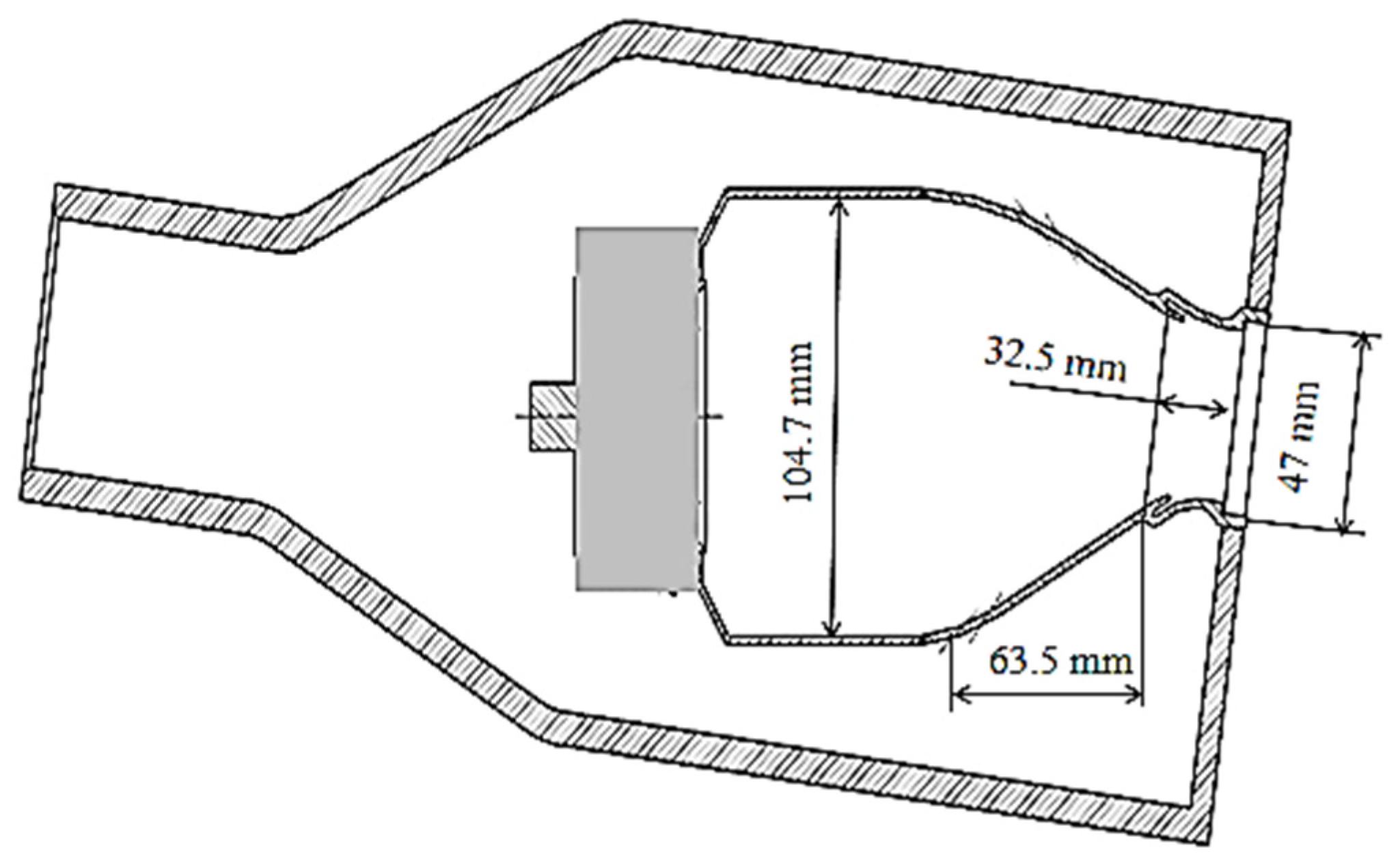

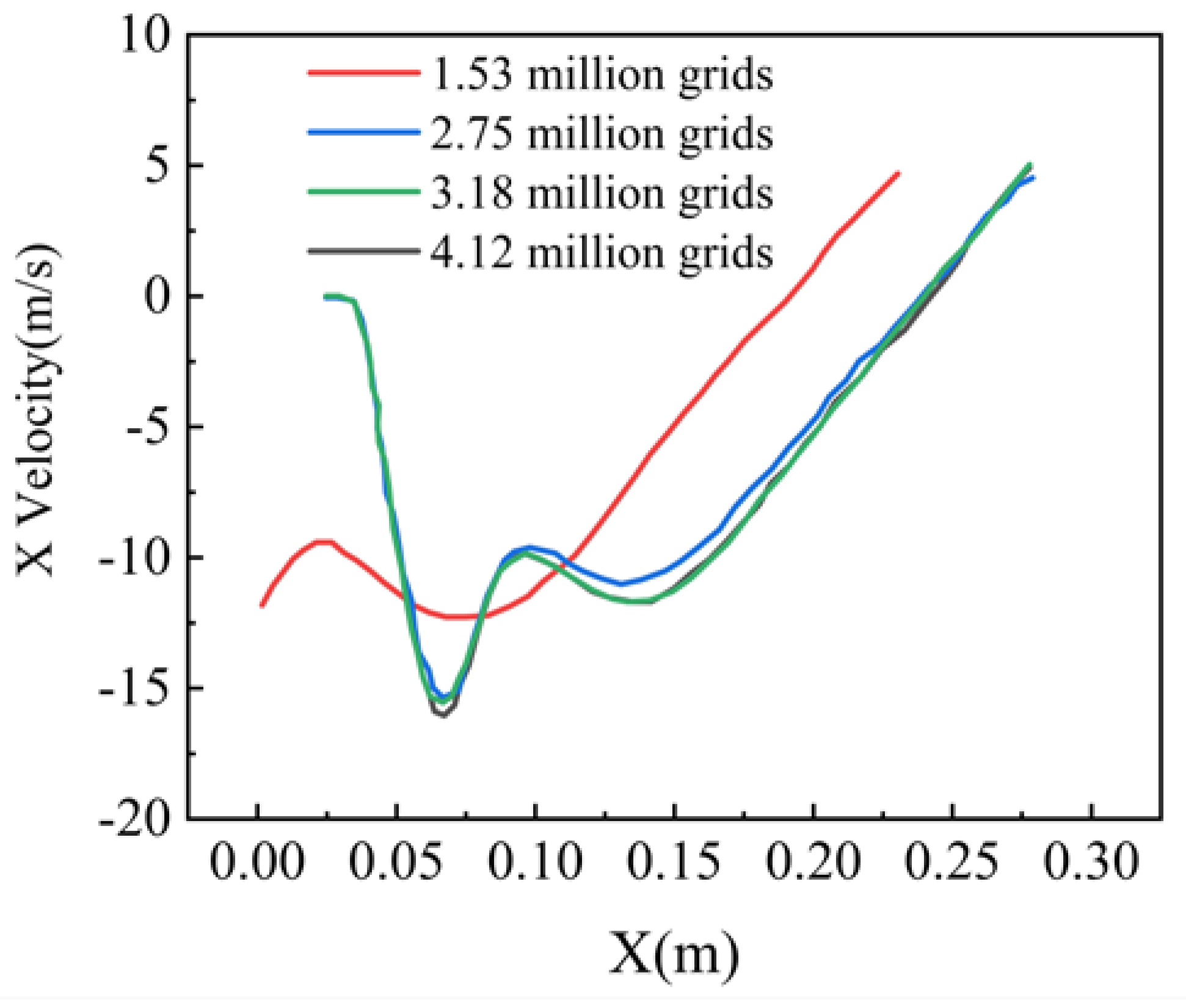

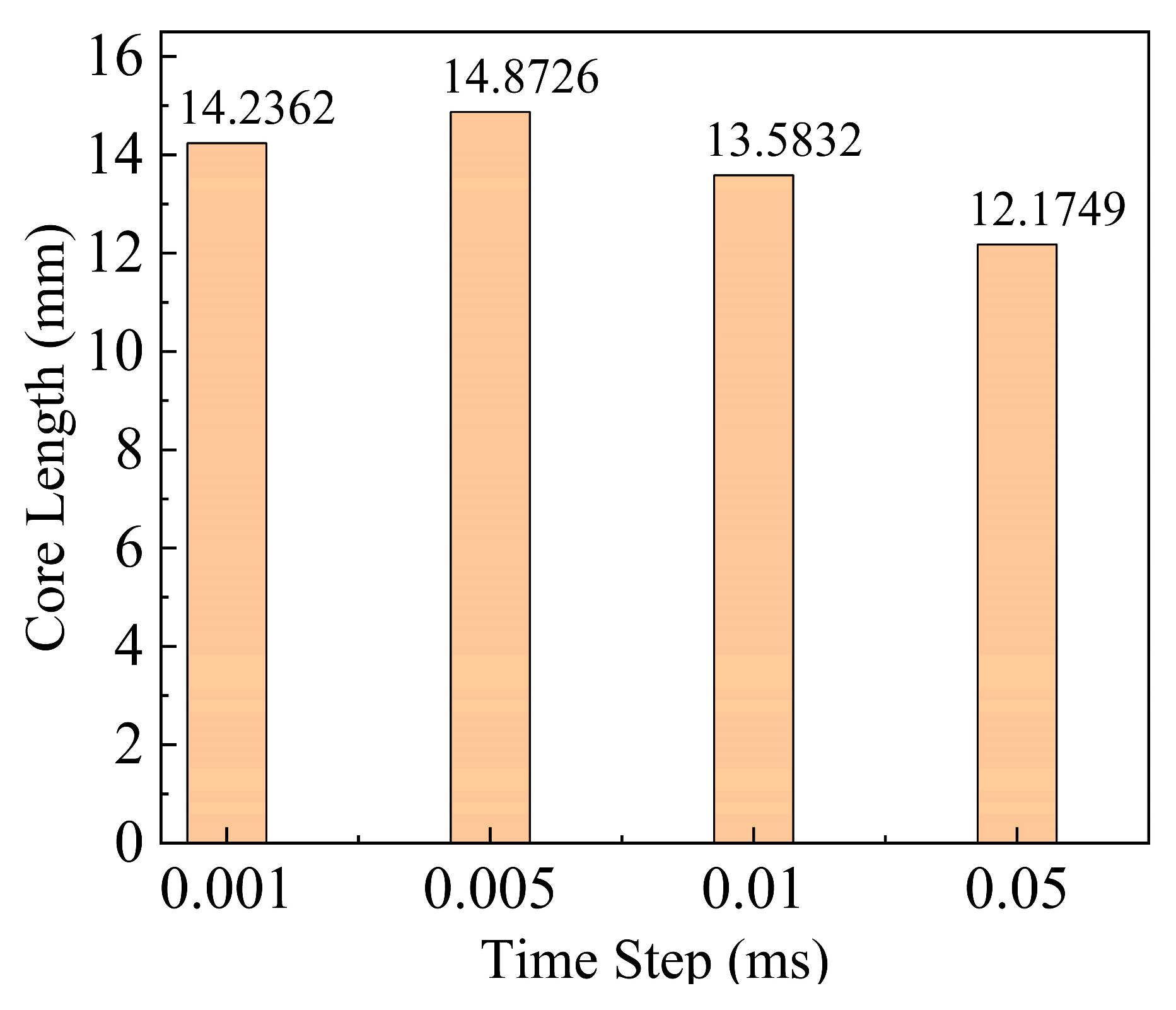
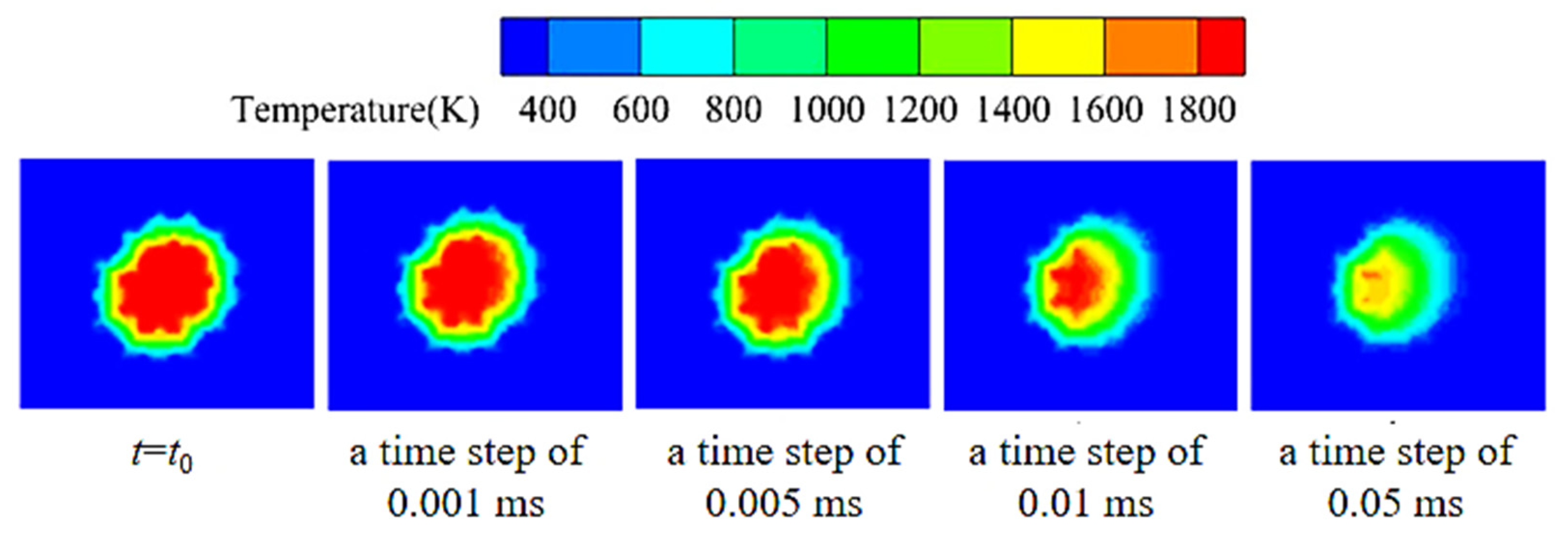

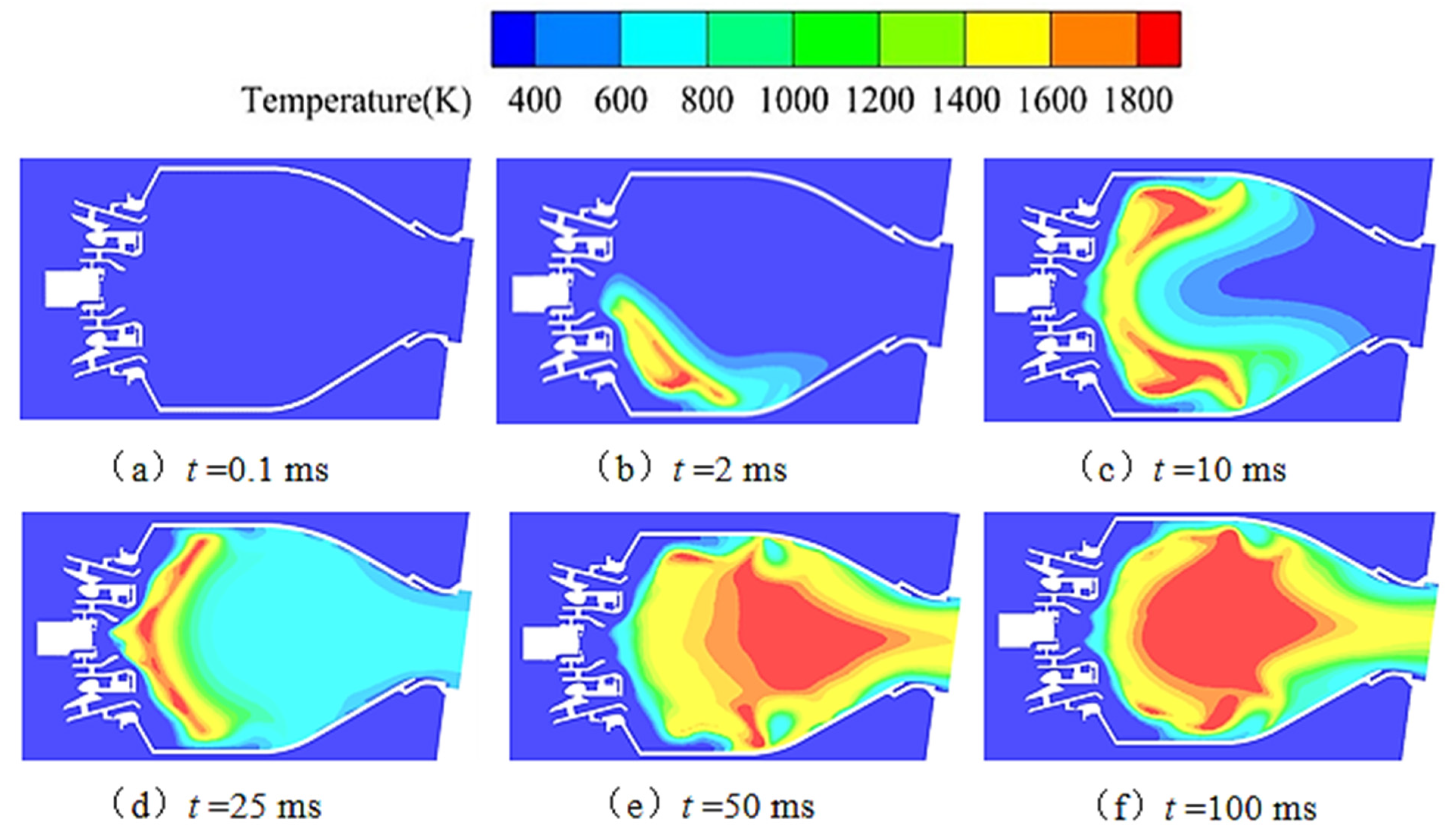


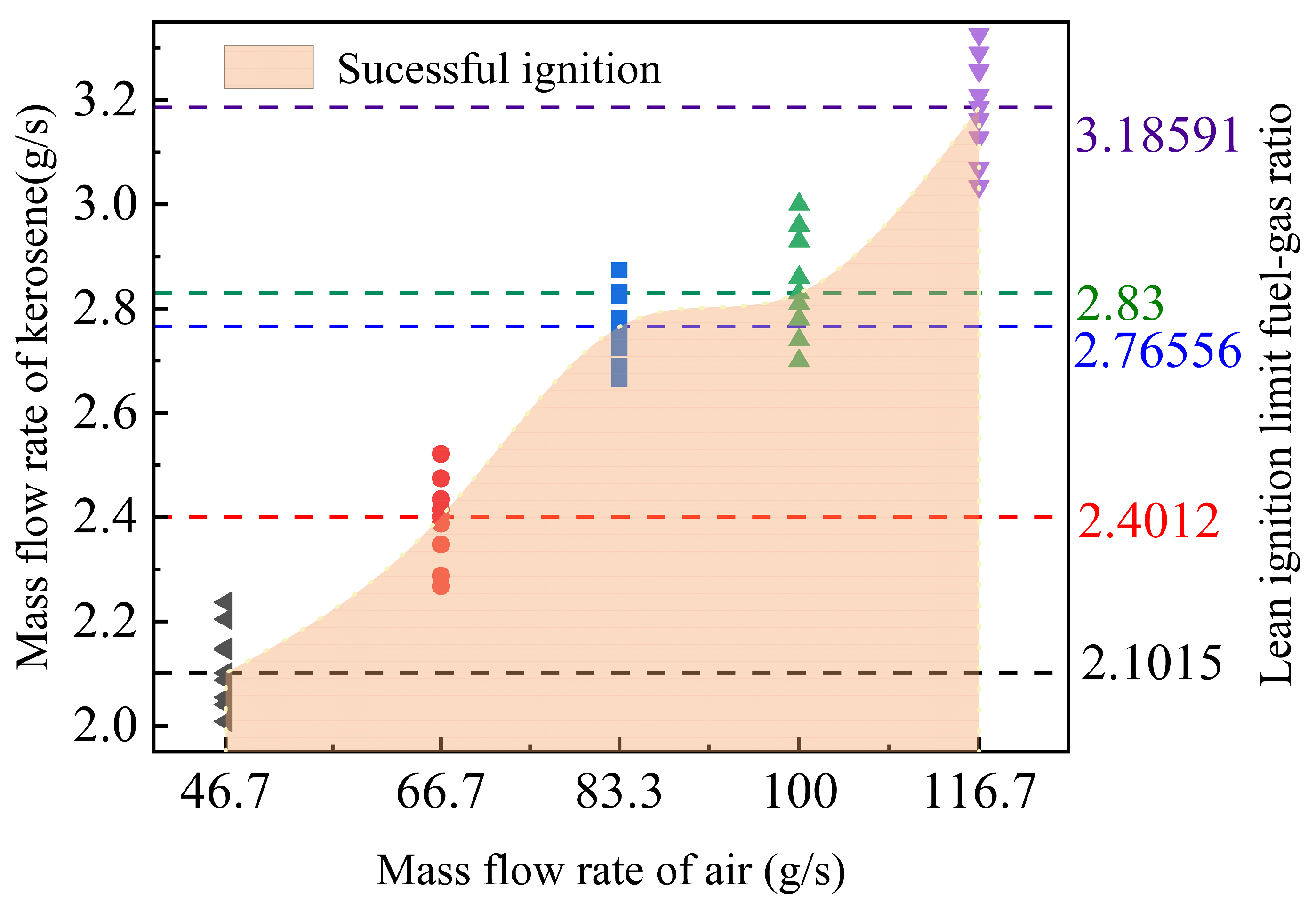

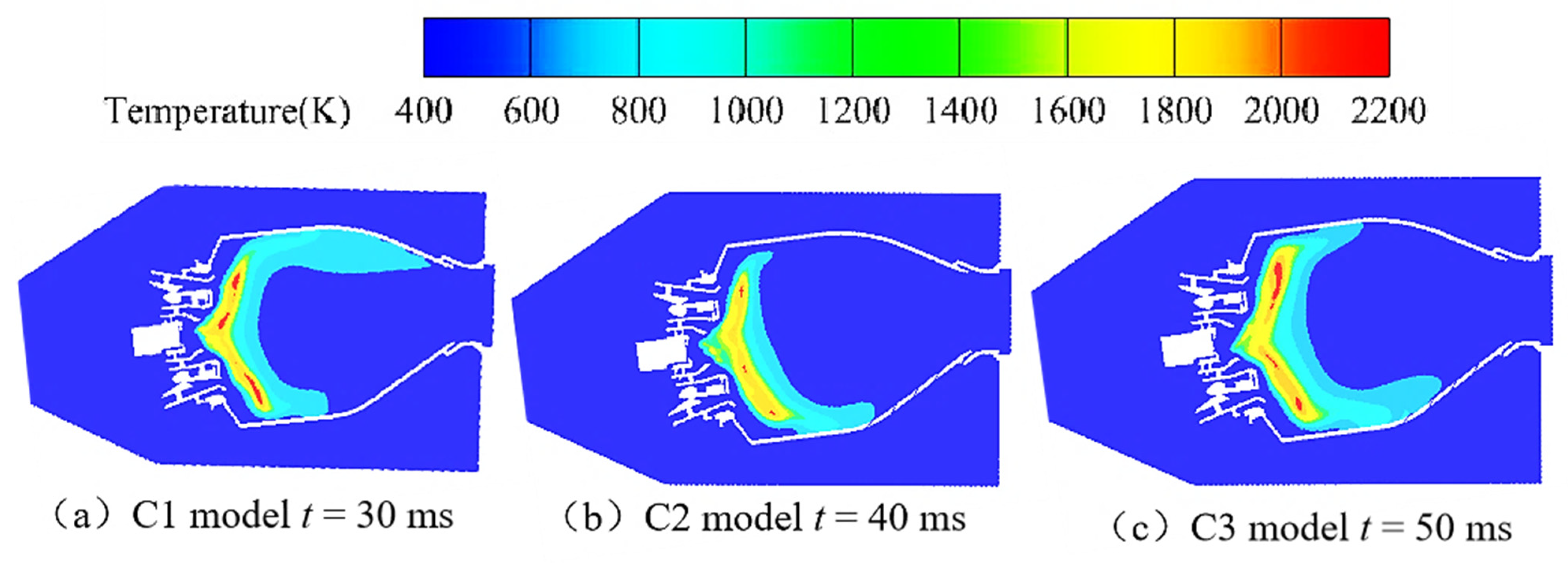
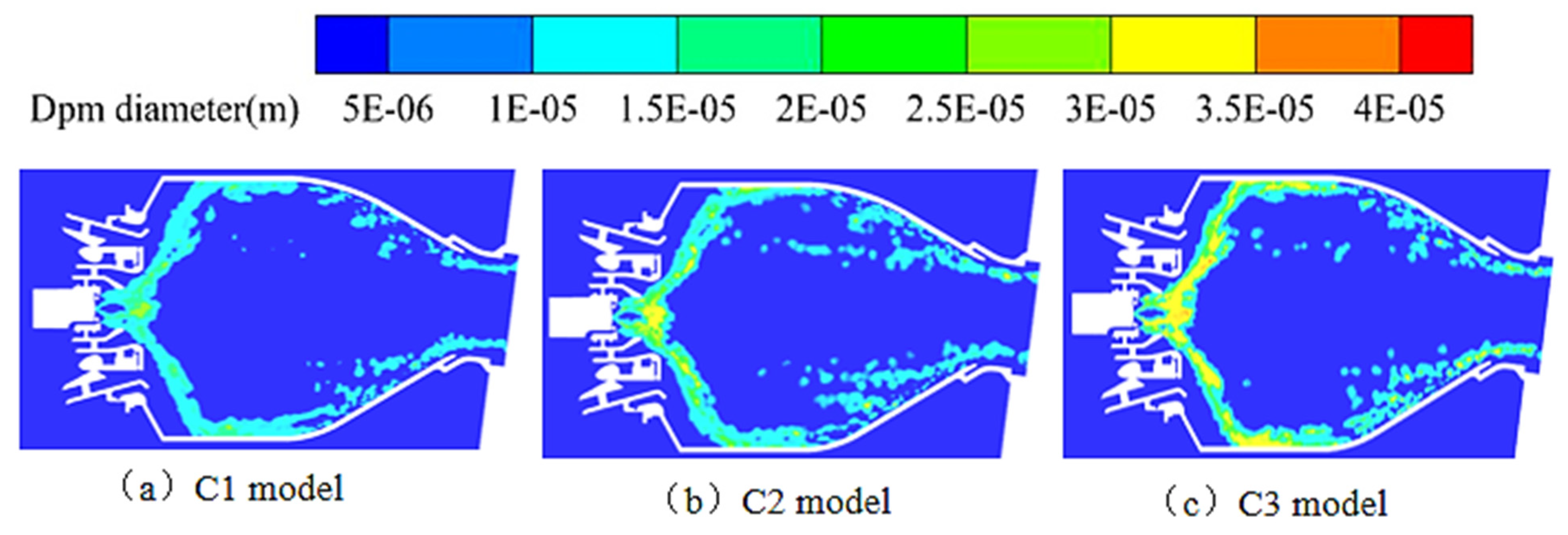



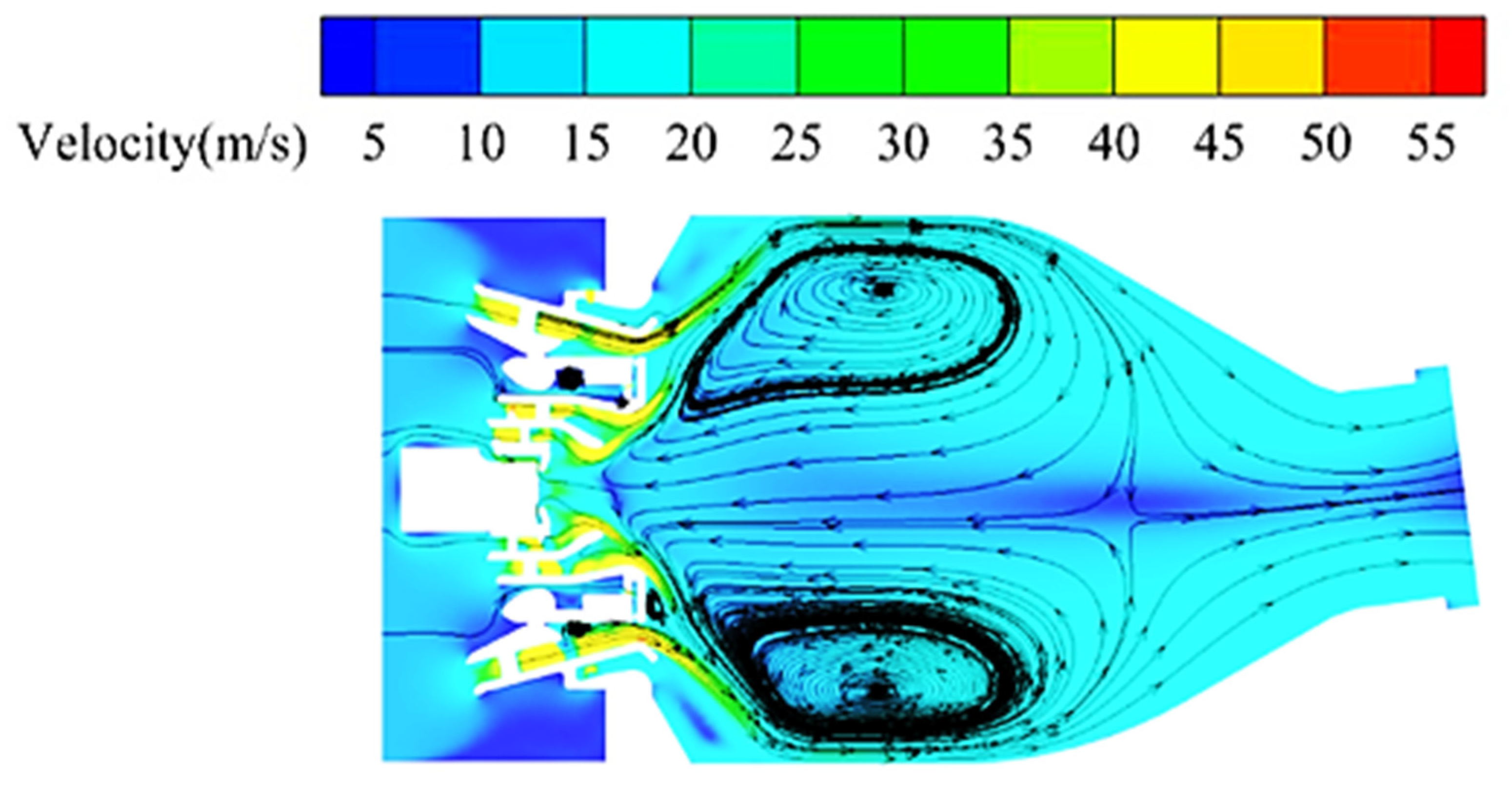

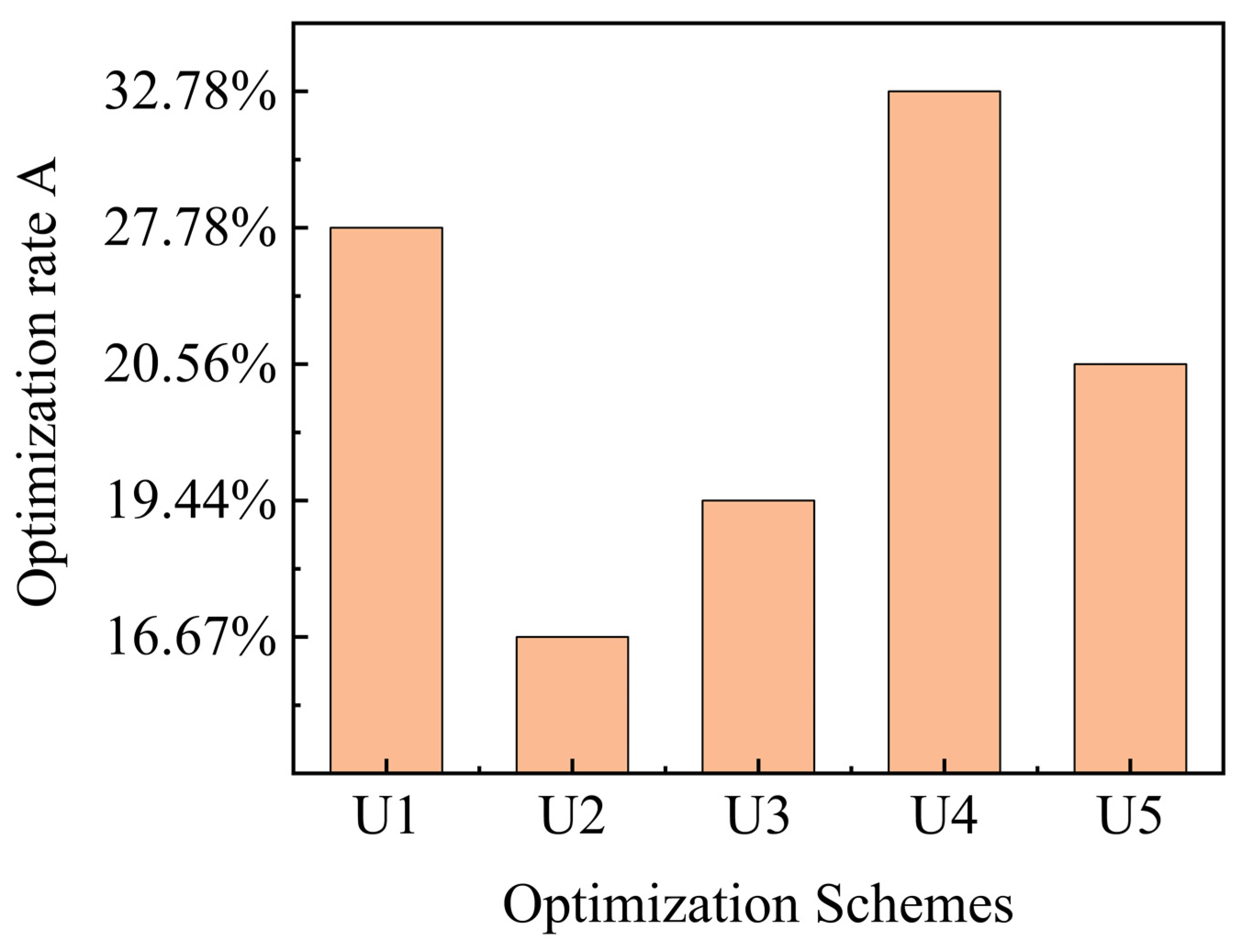
| Scheme | The Diameter of the Auxiliary Fuel Path Nozzles/mm | Swirl Direction Combinations of Pilot Swirlers | Swirl Number of Auxiliary Swirlers |
|---|---|---|---|
| C1 | 0.4 | Same | 1.2 |
| C2 | 0.5 | Same | 1.2 |
| C3 | 0.6 | Same | 1.2 |
| C4 | 0.4 | Opposite | 1.2 |
| C5 | 0.4 | Same | 0.8 |
| C6 | 0.4 | Same | 1.6 |
| U1 | 0.2 | Opposite | 1.2 |
| U2 | 0.2 | Opposite | 1.0 |
| U3 | 0.2 | Opposite | 1.1 |
| U4 | 0.2 | Opposite | 1.4 |
| U5 | 0.2 | Opposite | 1.6 |
| Air Inlet Mass Flow Rate (g/s) | Lean Ignition Fuel–Gas Ratio (Numerical Simulation) | Lean Ignition Fuel and Gas Ratio (Experimental Results) | Gap |
|---|---|---|---|
| 46.7 | 0.041 | 0.045 | 8.9% |
| 66.7 | 0.039 | 0.036 | 8.3% |
| 83.3 | 0.036 | 0.0332 | 9.9% |
| 100 | 0.031 | 0.0283 | 9.5% |
| 116.7 | 0.030 | 0.0273 | 9.9% |
| Scheme | Lean Ignition Fuel–Gas Ratio Limit |
|---|---|
| C1 | 0.018 |
| C2 | 0.0185 |
| C3 | 0.019 |
| Scheme | Lean Ignition Fuel–Gas Ratio Limit |
|---|---|
| C1 | 0.018 |
| C4 | 0.014 |
| Scheme | Lean Ignition Fuel–Gas Ratio Limit |
|---|---|
| C1 | 0.018 |
| C5 | 0.03 |
| C6 | 0.02 |
Disclaimer/Publisher’s Note: The statements, opinions and data contained in all publications are solely those of the individual author(s) and contributor(s) and not of MDPI and/or the editor(s). MDPI and/or the editor(s) disclaim responsibility for any injury to people or property resulting from any ideas, methods, instructions or products referred to in the content. |
© 2025 by the authors. Licensee MDPI, Basel, Switzerland. This article is an open access article distributed under the terms and conditions of the Creative Commons Attribution (CC BY) license (https://creativecommons.org/licenses/by/4.0/).
Share and Cite
Guo, Z.; Lu, Y.; Yuan, J.; Chen, P.; Zhang, Q.; Fan, W. The Effects of Pilot Structure on the Lean Ignition Characteristics of the Internally Staged Combustor. Energies 2025, 18, 349. https://doi.org/10.3390/en18020349
Guo Z, Lu Y, Yuan J, Chen P, Zhang Q, Fan W. The Effects of Pilot Structure on the Lean Ignition Characteristics of the Internally Staged Combustor. Energies. 2025; 18(2):349. https://doi.org/10.3390/en18020349
Chicago/Turabian StyleGuo, Zhengyan, Yan Lu, Jingtao Yuan, Pimin Chen, Qibin Zhang, and Wei Fan. 2025. "The Effects of Pilot Structure on the Lean Ignition Characteristics of the Internally Staged Combustor" Energies 18, no. 2: 349. https://doi.org/10.3390/en18020349
APA StyleGuo, Z., Lu, Y., Yuan, J., Chen, P., Zhang, Q., & Fan, W. (2025). The Effects of Pilot Structure on the Lean Ignition Characteristics of the Internally Staged Combustor. Energies, 18(2), 349. https://doi.org/10.3390/en18020349






